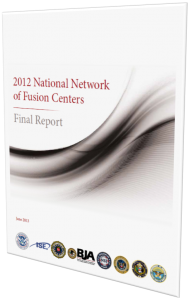DHS Fusion Center Assessment Report is out…How’d we do?
 The Department of Homeland Security (DHS) released its 2012 National Network of Fusion Centers Assessment Report and the results are encouraging. DHS reported that (overall) fusion centers improved their capability scores by 11 points over the 2011 assessment report card. Summary findings, based on Critical Operating Capabilities (COCs):
The Department of Homeland Security (DHS) released its 2012 National Network of Fusion Centers Assessment Report and the results are encouraging. DHS reported that (overall) fusion centers improved their capability scores by 11 points over the 2011 assessment report card. Summary findings, based on Critical Operating Capabilities (COCs):
COC 1 – Receive
- All fusion centers (77 or 100%) have access to federally sponsored Sensitive But Unclassified (SBU) information sharing systems.
- Every fusion center (77 or 100%) has at least one person cleared to access Secret information, but regular staff turnover means that fusion centers will continue to request new clearances (approximately 500 new clearance requests in the next 12 months).
- A significant number of fusion centers have on-site access to classified information sharing systems (66 or 85.7%).
- Fusion center use of the DHS Secret Internet Protocol Router Network (SIPRNet) Whitelist (Whitelist) is limited (41 or 53.2%).
COC2 – Analyze
- Fusion centers are highly involved in assessing threat and risk for their area of responsibility (AOR) (72 or 93.5%).
- Fusion centers are obtaining and using customer feedback on their analytic products (structured feedback: 65 or 84.4%).
- Analytic production plans are used widely across the National Network (60 or 77.9%).
- Critical infrastructure protection capabilities continue to expand across the National Network (75 or 97.4%).
COC 3 – Disseminate
- Despite progress since 2011, less than half (35 or 45.5%) of the National Network have a process in place to verify that customers are receiving their products.
- Fusion centers are increasingly designating a single, primary information sharing system (72 or 93.5%), but Homeland Security Information Network (HSIN) Intel is not frequently cited (23 or 29.9%) as the primary system for unclassified communication between fusion centers.
COC 4 – Gather
- The number of fusion centers that have developed Standing Information Needs (SINs) has increased (59 or 76.6%), but continued attention to SINs development is necessary.
- The National Network has a robust request for information (RFI) management capability (69 or 89.6%).
- A significant percentage of the National Network are involved in the Nationwide Suspicious Activity Reporting (SAR) Initiative (NSI), in particular in providing line officers with information on the behaviors identified in the Information Sharing Environment (ISE)-SAR Functional Standard (SAR line officer training: 66 or 85.7%).
DHS has identified three areas for improving fision center capabilities:
- Use Standing Information Needs (SINs) as the foundation of a customer-driven fusion process:
Fusion centers need to have a process for a) deriving and cataloguing regional and federal information and intelligence needs SINs , and b) actively tagging/associating these SINs with the information and intelligence products they produce. - Document key business processes and ensure consistent access to training:
High turnover in critical fusion center staff positions is going to be the norm, for a number of reasons – staff rotations, augmentation, contract renewals, promotions, etc. Fusion Center Directors must plan for this “churn” by taking the time to a) document the center’s core business processes, b) keep SOPs and policies up to date, and c) develop training and other performance support tools to minimize the impact of staff turnover on center operations. - Implement organizational planning and evaluation processes to continuously improve fusion center operations:
Fusion centers should clearly develop and communicate their center’s mission, goals, and objectives by developing a strategic plan, and using that plan as a tool to measure its performance. The strategic plan and periodic performance reports should help to communicate how investments in the fusion center result in tangible results, and b) help to drive annual budget requests to sustain or enhance current center capabilities.
I see gaps in these areas in my own work with fusion centers…unfortunately, many fusion centers are so busy with operational activities, that developing SOPs, training, strategic plans, etc., ends up on the back burner.
One other area, not directly addressed by the DHS assessment process is the development of an effective plan and roadmap for building an IT infrastructure that supports the four COCs. This too gets relegated to the back burner. In some cases, IT is addressed, but in a piecemeal fashion – Fusion Center Directors should elevate the need for an integrated IT plan, one developed from Fusion Center business processes and describes three key areas.
Suggested Components of a Fusion Center IT Strategy
- Information and Intelligence exchanges – what information, data, and intelligence comes-in and goes-out of the Fusion Center?
- What functional capabilities does the Fusion Center have now and which systems deliver those capabilities? (as-is)
- What NEW functional capabilities does the Fusion Center need, and how will the center procure them? (to-be)
- How much money does the Fusion Center need to a) sustain current capabilities and b) to implement the new capabilities?
Feel free to reach out to me if your center would like to discuss enhancing your operational and/or IT planning capability.
r/Chuck